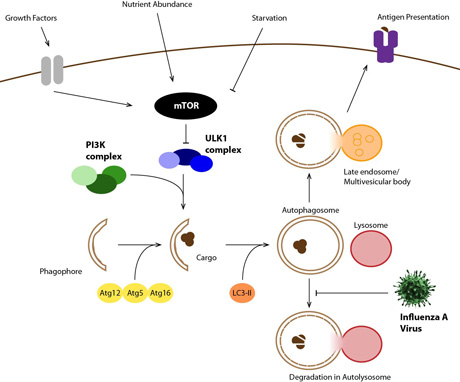Regulation of macroautophagy by viral pathogens
Each year Influenza A virus causes approx. 300.000 deaths worldwide. Because of a high degree of recombination of its surface epitopes long lasting immunity cannot be achieved. Newly recombined strains appear every so often and can cause epidemic outbreaks.
A major pathway cells utilize to breakdown intracellular material is macroautophagy. This degradation process also plays an important role in providing antigens for presentation to T cells. Some viruses have developed strategies targeting autophagy to evade immune recognition. Others utilize and even enhance autophagy to use it as a shelter or membrane source during their replication cycle. Understanding the intricate relationship between host cell and virus will help the development of novel vaccination and therapy strategies.
My work aims at gaining new insights into the molecular mechanisms underlying antigen delivery by autophagy. To elucidate the cross-talk between viral proteins and the autophagy machinery I am investigating matrix protein 2 (M2) of Influenza A. M2 was shown to cause a block of autophagosome/lysosome fusion(1), which could in turn lead to an accumulation of viral antigens in autophagosomes. How this influences viral pathology and immunogenicity is being studied using an autophagy-deficient mouse strain.
Identifying cellular factors that promote antigen presentation rather than degradation will yield novel targets for intervention with pathogens that usually evade the immune system by blocking autophagy. However, the implications of these findings are not necessarily limited to infection, as autophagy also plays a major role in many other diseases, such as neurodegenerative diseases.
| 1 | M. Ghannage et al., Matrix Protein 2 of Influenza A Virus Blocks Autophagosome Fusion with Lysosomes, Cell Host Microbe 2009 |
| 2 | S. M. Alavian et al., Virus-triggered Autophagy in Viral Hepatitis, J Viral Hepat, 2011 |

Figure adapted from (2)